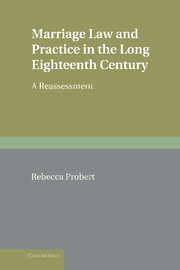Book contents
- Frontmatter
- Contents
- Preface
- 1 Introduction
- 2 The misunderstood contract per verba de praesenti
- 3 The myths of ‘informal’ and ‘common-law’ marriage
- 4 The little-considered marriage practices of non-Anglicans
- 5 The unacknowledged regularity of clandestine marriages
- 6 The eventual passage and actual terms of the 1753 Act
- 7 The unappreciated success of the 1753 Act
- 8 The unexplored judicial interpretation of the 1753 Act
- 9 The overlooked response of non-Anglicans
- 10 Conclusion
- Index
- References
3 - The myths of ‘informal’ and ‘common-law’ marriage
Published online by Cambridge University Press: 10 February 2010
- Frontmatter
- Contents
- Preface
- 1 Introduction
- 2 The misunderstood contract per verba de praesenti
- 3 The myths of ‘informal’ and ‘common-law’ marriage
- 4 The little-considered marriage practices of non-Anglicans
- 5 The unacknowledged regularity of clandestine marriages
- 6 The eventual passage and actual terms of the 1753 Act
- 7 The unappreciated success of the 1753 Act
- 8 The unexplored judicial interpretation of the 1753 Act
- 9 The overlooked response of non-Anglicans
- 10 Conclusion
- Index
- References
Summary
The argument advanced in the previous chapter was that a contract per verba de praesenti was not a full alternative to a regular marriage in that it did not carry the same legal rights as a marriage celebrated in church. This chapter asks whether, despite this, such contracts did in fact operate as a functional alternative to a regular marriage, as a number of commentators have claimed. This brings us back to the definitions of marriage and alternatives to marriage set out in the introductory chapter. It was there suggested that a ‘functional alternative’ would entail co-residence, a sexual relationship, and some recognition by the parties themselves, and by the wider community, that their relationship was equivalent to a formal marriage.
It is, of course, the combination of such elements that is important. In order to make a convincing case that a contract per verba de praesenti was the functional equivalent of a marriage in church, it would not be enough to show that some contracted couples engaged in sexual relations. There is a wide gulf between snatched moments of illicit passion and stable cohabitation. The evidence that some couples began sexual relations after entering into a contract to marry reflects the fact that such contracts, if witnessed, were legally binding, and that the woman had the security that she would be able to enforce it if she became pregnant; it does not indicate that the contract was regarded as the end of the process.
- Type
- Chapter
- Information
- Marriage Law and Practice in the Long Eighteenth CenturyA Reassessment, pp. 68 - 130Publisher: Cambridge University PressPrint publication year: 2009



